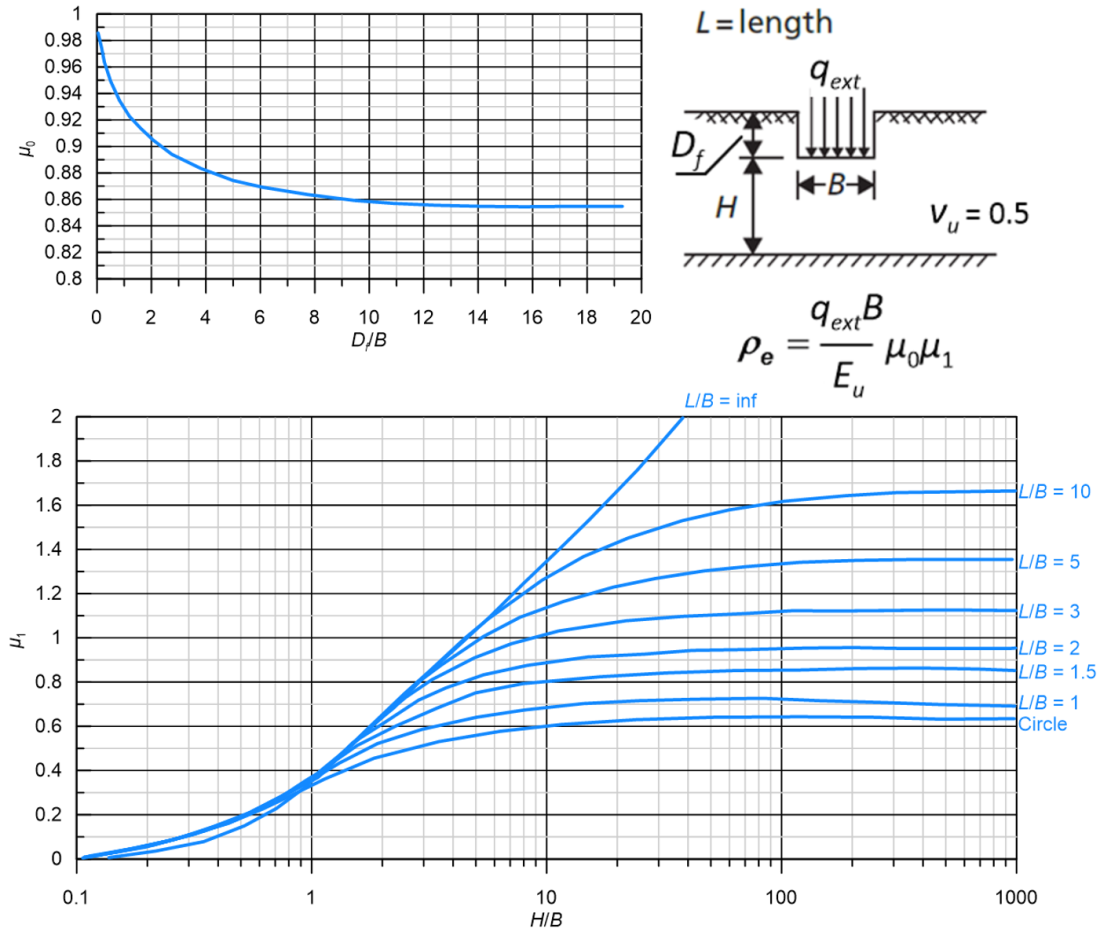4.5 Immediate settlement of shallow foundations
Elastic settlement of soil subjected to uniform, flexible loadings can be simply calculated as the sum of the volumetric strains εvol along the thickness of the compressible layer, Η:
(4.7) ![]()
The same basic concept applies for the estimation of settlement of shallow foundations. Nevertheless, we need to introduce some corrections in the above equation to account for the effect of the rigidity of the foundation, the embedment depth, and the shape of the footing, while appropriately considering drained or undrained conditions. These are discussed in the following paragraphs.
4.5.1 Effect of footing rigidity: Immediate settlement and contact stresses
Distortion of soil due to the application of an external load or pressure depends on the rigidity of the loaded area, and the type of soil (fine-grained or coarse-grained) i.e., whether immediately after application of a loading the soil will behave as drained or undrained. In case of rigid footings (Figure 4.10), settlement is of course uniform. The distribution of contact stresses below the footing is, nevertheless, highly non-uniform. Assuming that soil behaves as elastic material, contact stresses at the outer edge of the footing (x = B/2, Figure 4.10) would become infinite:
(4.8) 
In a real fine-grained soil however, they are limited by its shear strength. The drained Young’s modulus E′ of coarse-grained soils depends on the degree of confinement, and this affects the distribution of stress underneath a loaded area. The fact that the drained Young’s modulus E′ depends on the confining stress is mathematically expressed as:
(4.9) ![]()
where p′ is the mean effective stress p′ = (σ′1+σ′2+σ′3)/3, Ε′ref is the reference modulus value at a reference mean stress pref, while the exponent m is considered usually m = 0.5 for sands and m = 1.0 for clays. In other words, the Young’s modulus is non-linear function of mean stress in sands. Near the outer edges, where confinement (i.e., the mean stress) is less compared to the centre of the footing, the stresses are lower (Figure 4.10b).
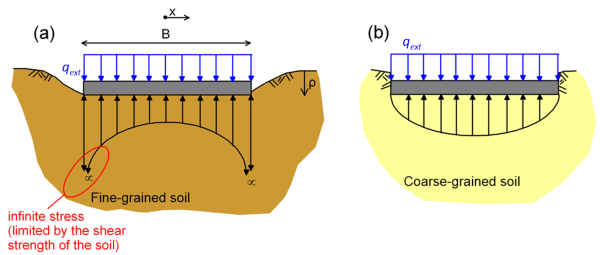
Contact stress distribution under a flexible loaded area is uniform, but the settlement profile varies as soil surface is free to deform, depending again on whether soil is fine-grained or coarse-grained (Figure 4.11). The shape of the deformed surface in the case of saturated clay (undrained loading) will be concave upward (Figure 4.11a), as it is reasonable to assume a uniform value of Eu across the thickness of the compressible clay layer, as in Figure 4.10a. On the other hand, the shape of the deformed surface in the case of a coarse-grained material (drained loading) will be concave downward (Figure 4.11b). That is because the Young’s modulus of sands E′ varies non-linearly with confining stress. As the latter are lower near the edge of the footing, compared to the stresses at its centre, the settlement developing near the edges will be higher than near the centre of the footing.

4.5.2 Effect of embedment depth
The pressure acting on the soil that will result in ground settlement is the additional pressure Δqext imposed at the level of the foundation, on top of the pre-existing geostatic vertical effective stress at this level, σ′z0. Settlement due to the stress σ′z0 has already taken place during soil deposition, before application of the loading.
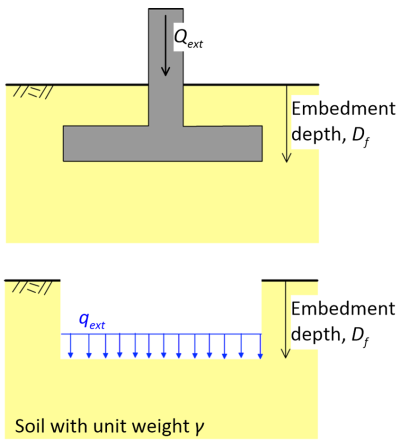
If the foundation level is at the ground surface, and no other loads exist (e.g., preloading) then σ′z0 = 0 and the additional pressure Δqext is equal to the pressure from the footing qext i.e., the applied force divided by the area of the footing Qext/(Area). But in the common case where the topsoil is excavated for the construction of the foundation level at depth Df (Figure 4.12) and soil is unloaded, the pre-existing vertical effective stress σ′z0 is equal to the geostatic stress at this level σ′z0 = γDf, where γ is the unit weight of the soil. In that case:
(4.10) ![]()
Besides, embedment of a foundation will further reduce the expected settlement as:
- Soil stiffness generally increases with depth. Foundation on a stiffer soil layer will of course result in less settlement.
- Normal stresses from the soil above the foundation level increase confinement.
- Part of the loading may be transferred through the side walls, as shear resistance can be mobilised at the soil-walls interface. Accommodation of part of the loading by side resistance reduces settlement (Figure 4.13).
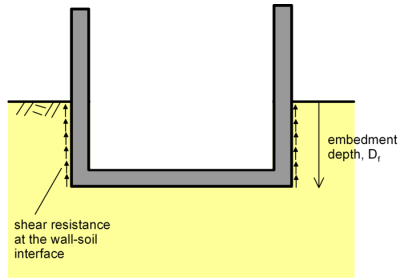
4.5.3 Drained or undrained soil response for calculating immediate settlements
Methods for estimating settlement which are based on the theory of elasticity are often applied to predict settlement of structures founded on coarse-grained (sand, gravel) soils. We use such methods while considering the drained elastic parameters of soil i.e., the drained Young’s modulus E′ (also referred to as compressibility modulus, or deformation modulus) and the drained Poisson’s ratio v′. As soil behaviour is actually non-linear, the appropriate value of the Young’s modulus to be used with a method assuming linear elastic soil behaviour should take into account the stress levels that are expected to be applied in soil (Figure 4.14). Of course it is prudent to design the foundation so that strains in the foundation soil under serviceability conditions remain low, therefore elasticity formulas should provide a relatively good approximation of soil behaviour in situ. Furthermore, one should keep in mind that the Young’s modulus generally increases with depth, as it is a function of the mean stress level (see Section 4.5.1).
For fine grained soils, if the applied stress is sufficiently less than the yield stress of soil, immediate (short term) settlement should indeed be approximately linear elastic. In fact, the author could argue that good design practice requires designing any foundation or earthwork (embankment) so that the yield stress of soil (i.e., its preconsolidation stress, see Section 4.6.2) is not exceeded immediately after loading the foundation soil. In that case, we can apply methods for estimating settlements that are based on the theory of elasticity, while considering the undrained elastic parameters of the soil i.e., the undrained Young’s modulus Eu, which can be estimated from triaxial undrained tests in soil samples (Figure 4.15) and the undrained Poisson’s ratio vu ≈ 0.5, that satisfies the requirement for zero volume change during undrained loading. Remember that according to the theory of elasticity, the undrained Young’s modulus, for deformation under constant volume, is related to the drained Young’s modulus as:
(4.11) ![]()
The theory behind the above Eq. 4.11 is discussed in Chapter 4.7.
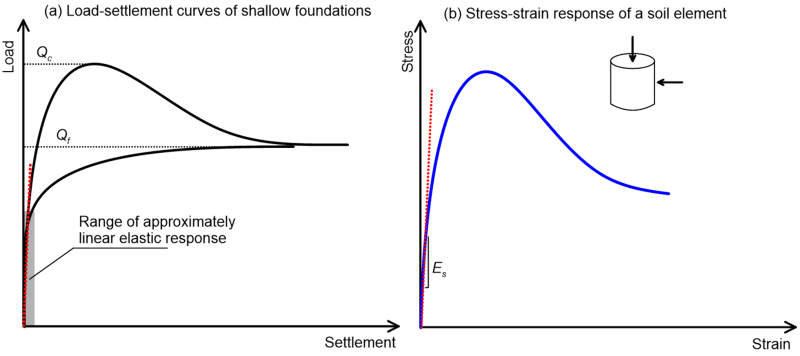
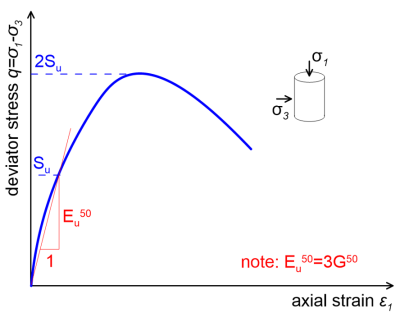
Keep also in mind that undrained loading under constant volume does not necessarily mean zero deformation, as it is the case of one-dimensional consolidation in the oedometer test. In two-dimensional problems, as the problem of predicting the immediate settlement of shallow footings, lateral soil heave is allowed to develop, and immediate settlement can occur under constant volume (see also Figure 4.9). This is also depicted in Figure 4.15, where undrained triaxial loading of a soil sample results in axial, but also lateral strains.
4.5.4 Immediate settlement of arbitrarily-shaped rigid footings on homogeneous half-space
The immediate (elastic) settlement of rigid shallow footings of arbitrary shape can be estimated using the following expression by Gazetas et al. (1985), which is based on the assumption of linear elastic soil resting on a homogeneous half-space (Figure 4.16):
(4.12) ![]()
where: Qext is the vertical load (units: force) acting on the footing under serviceability conditions; Es = Eu if the foundation soil is fine-grained (undrained conditions), or Es = E′ if the foundation soil is coarse-grained (drained conditions). In that case Eq. 4.12 provides the total settlement; vs = vu ≈ 0.5 if the foundation soil is fine-grained (undrained conditions), or vs = v′ if the foundation soil is coarse-grained (drained conditions); L is the half-length of the circumscribed rectangle.

Moreover, μs is a factor accounting for the shape of footing, equal to:
(4.13) ![]()
μemb is a factor accounting for the effect of embedment:
(4.14) ![]()
μwall is a factor accounting for the effect of wall friction:
(4.15) ![]()
The parameters that appear in the above expressions are defined in Figure 4.16, while values of the ratio Ab/4L2 for common footing shapes are presented in Table 4.3.
| Footing shape | Ab/4L2 |
|---|---|
| Square | 1 |
| Rectangle | B/L |
| Circular | 0.785 |
| Strip | 0 |
This method is valid for “deep” homogeneous soil. In practice this means that the thickness of the surficial compressive layer should be larger than the influence depth of the load. If that is not the case, the method will result in (over)conservative settlement predictions, as discussed in Example 4.8. In addition, it is the author’s view that the factor accounting for the wall friction must be used with caution, as it is not at all certain that the interface’s shear strength will be mobilised at the wall-soil interface under the serviceability load. It is therefore reasonable to assume that μwall = 1 i.e., no load is transferred through friction.
Note that the method described above does not apply to strip footings, as it predicts infinite settlement. This is a consequence of assuming that the thickness of the compressible layer is infinite.
4.5.5 Immediate settlement of footings on fine-grained soil layer of limited thickness
When the thickness of the compressible soil layer relatively to the dimensions of the foundation is relatively small, and the compressible soil is underlain by a practically incompressible layer, the method described in Section 4.5.4 will provide over-conservative settlement predictions. If the foundation soil is fine-grained, the immediate settlement of a flexible footing transferring pressure qext to a soil layer of finite thickness can be calculated according to Christian and Carrier (1978) as:
(4.16) ![]()
where μ0 accounts for the effect of embedment and μ1 accounts for the thickness of the compressible layer relatively to the dimensions of the footing (Figure 4.17). In addition B is the width of the footing and Eu is the undrained Young’s modulus of the fine-grained soil. Note that Figure 4.17 depicts values of μ0 and μ1 that correspond to Poisson’s ratio vu = 0.5, hence the above are valid only for undrained loading conditions.
